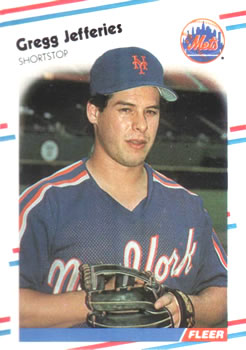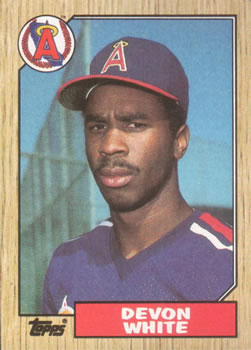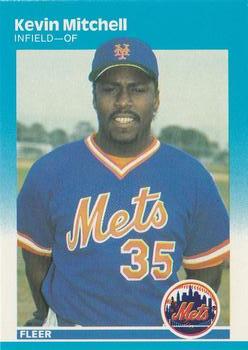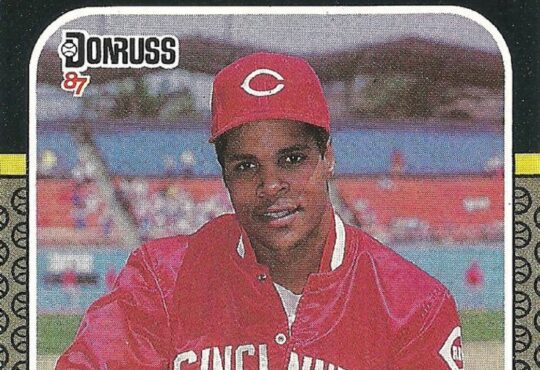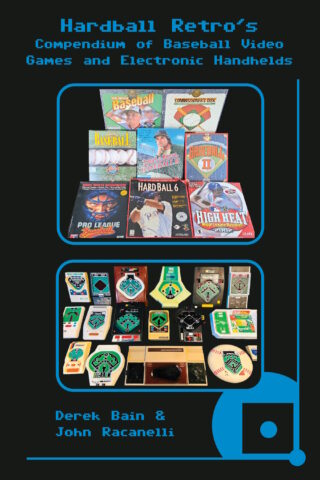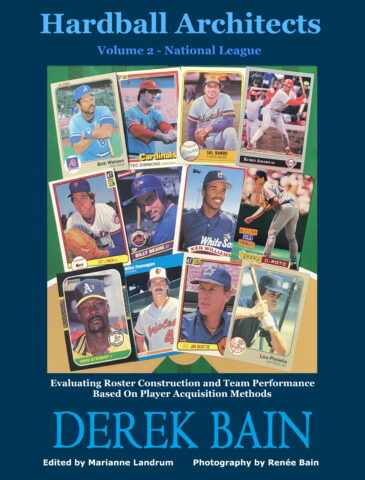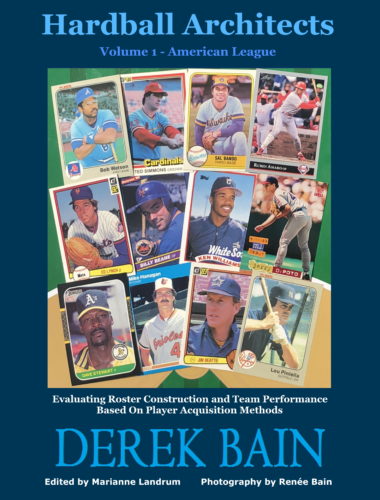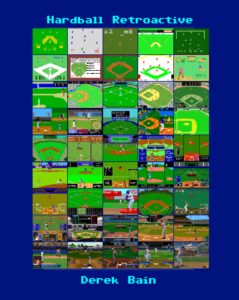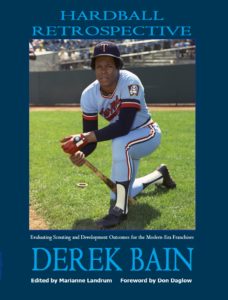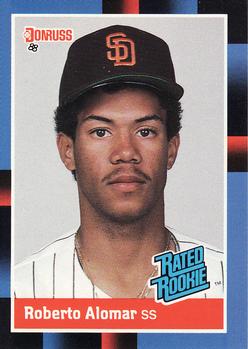
The 1988 Donruss Baseball Card Set
Derek’s (Re)collections
A half-decade of innovative design came to a screeching halt as the 1988 Donruss offering featured a rather bland format on the card fronts. The photography remained on par with previous efforts but the border and overall layout failed to impress me. The ‘88 sets in general suffer from a dearth of prospects when compared to prior seasons. Donruss could be forgiven for an off-year but several new manufacturers joined the ranks as the decade drew to a close and the fight for collector’s attention led to additional bloat in product lines.
Corby Corner
1988 represented the turning point in 1980’s card collecting to me. It was at this moment that it became a business and printing cards meant printing cash for the companies. Sadly this left too many cards of average players in the mix. Coming off of what I felt was the strongest and most consistent four years of cards by any company in the business overall, the 1988 Donruss set disappointed. Now I understand that a set is only as good as the players within, especially the rookies, but this set struggled on players and design. The background felt “safe” and not what the last two years of Donruss cards embodied. The pictures were mostly standstill shots, the “Rated Rookies” didn’t really create excitement, and the one ballyhooed rookie, Gregg Jefferies, never really panned out. Every year can’t have an ‘83 rookie crop, but this one was flat and really hurt all sets during the year. I was willing to give Donruss a mulligan after their climb the past five years and looked forward to 1989. Little did I know…
Features
The 1988 Donruss cards consist of a predominantly blue border with several black and red accents. The player’s name and primary position are listed in white on a red background towards the bottom of the card. The Donruss ‘88 logo appears in the top left corner while the player’s team logo sits near the bottom right.
Diamond Kings (one player per team) run from card 1 through 26 with a “DK” checklist included as card # 27 highlighted by Mark McGwire (#1) and Cal Ripken Jr. (#26). The Rated Rookies subset (card 28 through 47) features Roberto Alomar (#34) and Mark Grace (#40). The “Ripken Baseball Family (Billy Ripken / Cal Ripken Sr. / Cal Ripken Jr.)” is depicted on card # 625 and Stan Musial puzzle appears on card # 641.
Donruss eliminated their Highlights and Opening Day offerings in favor of a 336-card “Baseball’s Best” set which borrowed the design from the standard ‘88 Donruss set but modified the border colors to orange and black. The Rookies set also shared a similar appearance while utilizing a green, red and black border. Brady Anderson and Chris Sabo top a mediocre lineup in the Rookies set. All-Stars, Pop-Ups and Super DK’s survived the cut for another go-round in ‘88. Donruss inserted bonus MVP’s into random wax and rack packs. The only way to distinguish the MVP’s from the standard cards is the “MVP” logo on the front and the “BC” (bonus card) prefix in the card numbering on the backs.
The subset values according to the 1997 edition of the Beckett Almanac of Baseball Cards and Collectibles are as follows: Rookies $15, Baseball’s Best $15, All-Stars $8, Bonus MVP’s $3, Pop-Ups $5, Super DK’s $12.
One-and-Dones
The players listed below made their lone appearance on a regular-issue baseball card in the 1988 Donruss set. Appearances on multi-player “rookie” or “top prospect” cards are not included – this is limited to individual cards for each particular player.
Manny Hernandez (# 481) – The long road to the Majors began in November 1978 when Manny Hernandez signed a contract with the Houston Astros as a 17-year-old amateur free agent. He registered a pair of wins along with a 2.57 ERA in nine relief outings during his inaugural campaign in the Gulf Coast League in ‘79. Hernandez won 5 of 7 decisions in the following year for the GCL Astros before spending three successive seasons (1981-83) with the Daytona Beach (A) squad where he compiled a 22-14 record with an ERA of 3.82. The right-handed continued his slow march to the Majors over the next three years with the Tucson Toros (AAA). He finally reached the big leagues in June 1986 when Houston needed a healthy arm in the starting rotation to replace the injured Nolan Ryan. The “Ryan Express” was placed on the 21-day disabled list with an elbow injury (New York Times, June 2, 1986). Hernandez took the mound at Dodger Stadium on June 5, 1986 and held Los Angeles to 3 hits in 5 ⅔ innings. After notching his first MLB strikeout (Mike A. Marshall in the fourth inning), he was saddled with a hard-luck 1-0 defeat after serving up a triple to Steve Sax and a sacrifice fly to Ken Landreaux in the bottom of the sixth inning. One week later he claimed his first MLB victory, 4-1 over the Giants when he yielded one run in 5 ⅔ innings. His ERA climbed from 1.59 to 2.86 with a pair of sub-par starts at Cincinnati and San Francisco whereupon Ryan was activated and reclaimed his spot in the rotation. Hernandez recorded a victory with a scoreless inning in relief against the Dodgers on June 29, 1986 but the Padres roughed him up two days later (⅓ IP, 3 H, 2 BB, 4 ER) resulting in a demotion to triple-A. He continued to pitch well for Tucson and earned a September call-up. In three relief appearances, Hernandez hurled 4 ⅓ IP with 4 strikeouts and only one earned run to finish his rookie year with a record of 2-3 and an ERA of 3.90. He returned to Tucson and compiled a 3.00 ERA with a 1.056 WHIP in 9 starts to merit a September call-up. Hernandez held the Cubs to three runs (one earned) over 7 innings in a home start against the Cubs on September 1, 1987 but he was saddled with a 3-2 loss. His ERA swelled from 1.29 to 5.40 by the end of the season and Hernandez registered an 0-4 mark in 6 appearances (3 starts). Back with the Toros for a fifth consecutive season and pitching in his eleventh year of professional baseball, Hernandez logged a pedestrian 10-9 record in 30 starts along with an ERA of 4.24. He was granted free agency in October 1988 and latched on with Minnesota one month later. The veteran minor leaguer was released in August 1989 after posting a 9-8 mark with a 3.91 ERA for the Portland Beavers (AAA). The Mets quickly signed him and he pitched “lights-out” for the Tidewater Tides. Over 7 appearances (6 starts) he fashioned an ERA of 1.69 and a WHIP of 0.914 to earn one last promotion to the big leagues. New York trailed Montreal 10-1 in the sixth inning on September 16, 1989 when Hernandez was summoned from the bullpen. The right-hander retired the Expos in order, inducing a pair of groundouts sandwiched around a swinging strikeout of catcher Mike R. Fitzgerald. Overall his MLB career statistics include a 2-7 record with a 4.47 ERA in 50 ⅓ innings pitched. He notched 12 victories in 23 decisions for Tidewater in ‘90 but the Mets did not add him to the expanded roster in September. Hernandez pitched one more minor league season, splitting time between the Tides and the Brewers triple-A affiliate in Denver while logging only 29 innings on the mound. He spent two campaigns with the Brother Elephants in Taipei (1995-96) and yielded a 10-12 mark before calling it a career.
Tom Newell (# 604) – Selected in the 24th round of the June 1983 Amateur Draft by the Fightin’ Phillies, Tom Newell was assigned to Helena (Rk) where he commenced his professional career as an outfielder. He compiled a .274 BA in 130 plate appearances but struggled mightily in the subsequent season as he slashed 185/.272/.237 for Bend (A-). Converted to a starting pitcher in ’85, Newell battled control issues but managed an ERA of 3.82 with Spartanburg (A). He showed significant improvement during the 1986 campaign as he fashioned a 2.90 ERA and reduced his WHIP from 1.520 to 1.297 across 27 outings (17 starts) for Clearwater (A) and Portland (AAA). Newell’s control problems resurfaced as he started 28 games for the Maine Guides (AAA) in ’87 with a composite 1.512 WHIP. Yet the Phillies promoted him to the big lesgues in September. Skipper Lee Elia summoned Newell in the eighth inning as his ballclub trailed the Mets 9-5 on September 9, 1987. He retired Tim Teufel on a grounder to shortstop. Dave Magadan drew a base on balls, and then Darryl Strawberry clubbed a long drive deep into the left field seats. Kevin McReynolds and Gary Carter delivered successive singles to right, chasing Newell in favor of Freddie Toliver. Nine days later, the Expos roughed up Bruce Ruffin and Elia called upon the rookie right-hander with one out in the fourth, Phillies behind 4-0. Newell got Vance Law on a fly ball and issued an intentional pass to Mike R. Fitzgerald to bring the opposing starter to the plate. Newell notched his lone MLB strikeout when Bryn Smith went down looking. Tim Raines led off the next frame with a walk and promptly pilfered second base. Mitch Webster laced a triple down the right field line. Elia again brought Toliver out of tte pen. A sacrifice fly to right off the bat of Hubie Brooks closed the book on Newell’s outing. He did not appear in any more contests for Philly in September and thus finished the season and his MLB career with a 36.00 ERA. Newell backslid to Double-A in the middle of the ’88 campaign after he dropped 5 of 6 decisions while posting an ERA of 6.14 with Maine. After missing the entire 1989 season, Newell agreed to a minor league deal with the Yankees. He concluded his professional baseball career with a pair of sub-par seasons as a spare part in the NY farm system, yielding a 5.50 ERA between high-A and triple-A ball.
Randall Byers (# 605) – A four-time draft pick during the years when the MLB held their amateur draft in January and June of each year, Byers finally agreed to a contract after San Diego selected him in the first round (eight overall) of the 1984 MLB January Draft-Secondary Phase. He reported to the Spokane Indians (A-) where he played in 69 contests and batted .231 with 43 RBI and 13 stolen bases as a 19-year-old. He established personal-bests with 32 two-baggers and 94 RBI while slashing .319/.354/.461 for the Charleston Rainbows (A) in his sophomore campaign. Promoted to the Beaumont Golden Gators (AA) in ‘86, Byers increased his home run output to 11 at the expense of nearly every other offensive statistic from the prior campaign. Moving up the ladder to the Las Vegas Stars (AAA) in the subsequent season, he attained career-highs with 12 round-trippers and 14 stolen bases to merit a September recall. Byers made his big league debut with the Padres on September 7, 1987. Pinch-hitting in the eighth inning against Jim Acker of the Braves with his ballclub ahead 11-4, Byers flew out to left fielder Ken Griffey. Despite the Padres’ woeful record (the club finished the ‘87 season with a 65-97 mark), Byers rode the pine for a week before getting another opportunity to pinch-hit on September 15. Facing the Giants’ Jon Perlman with one out in the eighth and the Padres trailing 13-3, Byers laced a single to center field for his first MLB base knock. San Diego skipper Larry Bowa finally penciled Byers into the starting lineup with one week remaining in the Friars’ dismal season. Batting fifth on September 29 against Kelly Downs and the Giants, he notched a pair of hits including his lone two-base hit in “The Show”. Byers lifted his batting average to .500 with a 2-for-3 effort on October 1 against Cincinnati while registering his first run, RBI and stolen base. His BA dipped to .313 as he went hitless in six at-bats over the final three games. Byers was unable to crack the Opening Day roster but spent three weeks in May 1988 as a spare part off the Friars’ bench. He made no starts, appearing as a pinch-hitter in 11 contests. Byers drilled a double off Bob Walk in the eighth inning of a 1-1 pitchers duel on May 6, 1988 but Roberto Alomar grounded out to end the threat. The Bucs’ Sid Bream launched a three-run walk-off blast against southpaw Mark W. Davis in the twelfth frame. Byers, batting for Ed Whitson in the seventh inning of an eventual 3-2 loss to the Expos, rapped his last big-league base knock off Dennis Martinez on May 14, 1988. He went hitless in five pinch-hit appearances spanning the next week, culminating in a pop-up to Phillies’ shortstop Steve Jeltz against Steve Bedrosian on May 21, 1988. The Friars banished the backup outfielder to Las Vegas (AAA) for the remainder of the season where he drilled 27 doubles and batted an unremarkable .267. Byers kicked off the ‘89 campaign in fine fashion, slashing .328/.382/.656 across 16 contests for the Stars before San Diego flipped him to St. Louis in exchange for relief pitcher Jeremy Hernandez. Playing for the Louisville Redbirds he compiled a .260 BA in 94 games. Byers walked away from professional baseball after the 1989 season.
Did You Know?
In addition to biographical and statistical records, Donruss card backs incorporated each player’s “Career Highlights” along with their contract status and how they were acquired by their current team.
Jimmy Key (#72) – “In ‘85 became 1st LH starter to win a game for Blue Jays since ‘80, a total of 614 games”
Rob Murphy (#82) – “Set Major Lg. record for most appearances by L.H. pitcher last year.”
Manny Lee (#650) – “Was the only teenager on an opening day roster in Majors in ‘85.”
Errors
The 1988 Donruss set does not contain any significant error variations.
Rookie Cards
Tom Glavine, Roberto Alomar, Mark Grace, Ken Caminiti, Jeff Blauser, Al Leiter, David Wells, Jay Buhner, Ellis Burks, Matt Williams, Ron Gant, Jack McDowell and Roberto Kelly are among the players making their cardboard debuts in the ’88 Donruss set.
Price Guide (Then and Now)
The “Beckett Almanac of Baseball Cards and Collectibles” (1997 edition) cataloged the 1988 Donruss Baseball complete set at $8 while the Rookies set logged a $15 value.
Please add a comment below if you would like to share any memories from collecting the 1988 Donruss baseball card set or your experiences with card collecting in general!
Articles in the Series
References and Resources
Beckett, Dr. James, Rich Klein and Grant Sandground. Beckett Almanac of Baseball Cards and Collectibles. Dallas, TX: Beckett Publications, 1997. Print.
https://www.beckett.com/search/?term=1988+donruss&year_start=1988
http://www.tuffstuff.com/priceguides
http://www.baseballerrors.com/
Trading Card Database – Photo Gallery
https://www.tcdb.com/ViewSet.cfm/sid/119/1988-Donruss
About the Authors
Derek Bain is a New Jersey native with a passion for baseball, statistics, computers and video games who enjoys spending quality time with his family.
Tom Corby – Cousins with Derek, I am a history teacher at New Egypt High School. I have three kids, Addison, Jaclyn, and Mason and I’m happy that I get to coach them in their sports as well. In my spare time I enjoy reading, anything beach related, and fishing when time allows.
Derek’s Books
“Hardball Architects – Volume 1 (American League Teams)”, published in July 2020, is available in paperback and digital (Kindle) format at Amazon.com.
“Hardball Architects – Volume 2 (National League Teams)”, published in April 2022, is available in paperback and digital (Kindle) format at Amazon.com.
Hardball Architects examines the trades, free agent acquisitions, draft picks and other transactions for the 30 Major League Baseball franchises, divided into a 2-volume set (American League and National League). All key moves are scrutinized for every team and Sabermetric principles are applied to the roster construction throughout the lifetime of the organization to encapsulate the hits and misses by front office executives.
“Hardball Retroactive”, published in June 2018, is available in paperback and digital (Kindle) format at Amazon.com. Hardball Retroactive is a modest collection of selected articles that I have written for Seamheads.com along with my Baseball Analytics blog since 2010. Exclusive content includes the chapter on “Minors vs. Majors” which assesses every franchise’s minor league successes and failures in relation to their major league operations.
“Hardball Retrospective” is available in paperback and digital (Kindle) format at Amazon.com. Supplemental Statistics, Charts and Graphs along with a discussion forum are offered at TuataraSoftware.com. In Hardball Retrospective, I placed every ballplayer in the modern era (from 1901-present) on their original teams. Using a variety of advanced statistics and methods, I generated revised standings for each season based entirely on the performance of each team’s “original” players. I discuss every team’s “original” players and seasons at length along with organizational performance with respect to the Amateur Draft (or First-Year Player Draft), amateur free agent signings and other methods of player acquisition. Season standings, WAR and Win Shares totals for the “original” teams are compared against the real-time or “actual” team results to assess each franchise’s scouting, development and general management skills.
Don Daglow (Intellivision World Series Major League Baseball, Earl Weaver Baseball, Tony LaRussa Baseball) contributed the foreword for Hardball Retrospective. The foreword and preview of my book are accessible here.
“Hardball Retrospective – Addendum 2014 to 2016” supplements my research for Hardball Retrospective, providing retroactive standings based on Wins Above Replacement (WAR) and Win Shares (WS) for each “original” team over the past three seasons (2014-2016). Team totals from 2010 – 2013 are included for reference purposes. “Addendum” is available in paperback and digital (Kindle) format at Amazon.com.
